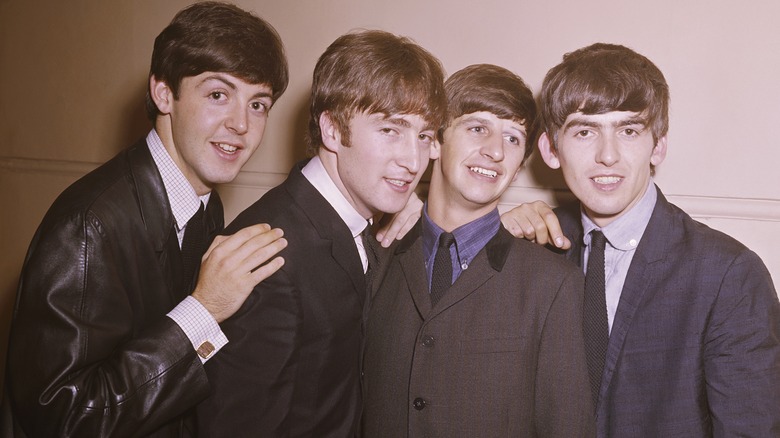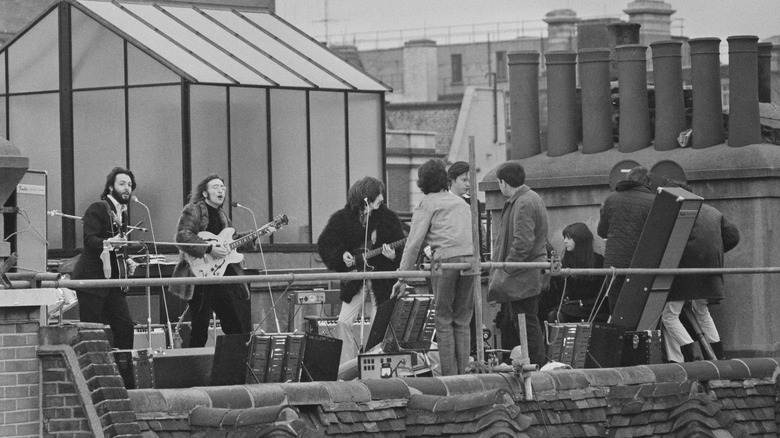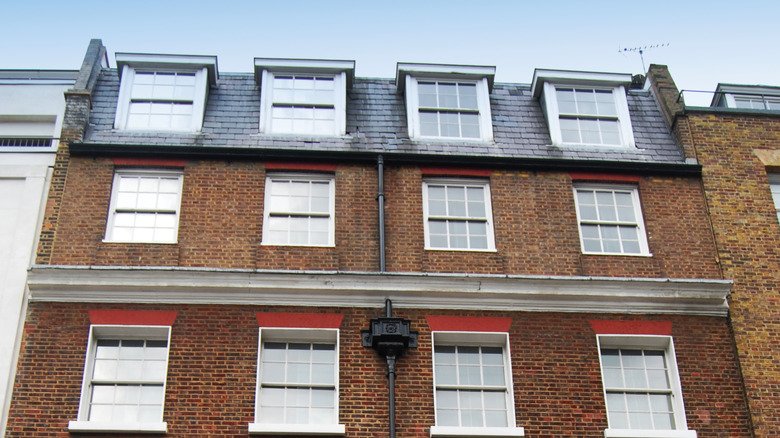The Reason The Beatles' 1969 Concert Took Place On A Rooftop Might Surprise You
The Beatles' decision to stop touring in 1966 came after a series of highly stressful incidents, including one in the Philippines, where die-hard supporters of President Ferdinand Marcos verbally — and even physically — attacked them and their entourage over their perceived snub of first lady Imelda Marcos' invitation to schmooze at Malacañang Palace (via The Vintage News). The band escaped mostly unscathed but were nonetheless shaken enough to retire from live performances after playing one last concert at Candlestick Park in San Francisco on August 29, 1966, per Rolling Stone. It didn't help that life on the road — not to mention all those concerts where they could barely hear themselves playing amid the screams from the crowd — was burning them out as musicians.
Then, for one brief moment, the Beatles were playing in front of people again — well, sort of. On January 30, 1969, the Fab Four convened on the rooftop of the Apple Corps headquarters in Savile Row, London, and played one final gig for a mostly bewildered audience of onlookers. Though this may have been the Beatles' smallest live audience (if you could call it one) in quite some time, it made for an iconic moment in pop culture history, one referenced so often in the five-plus decades that followed. Here's why the Beatles agreed to play this concert, and the reason why they chose such a venue in the first place.
The Beatles' final concert was meant for a TV documentary
After all the forays into experimental music, attempts to cover as many genres as possible, and dramatic infighting that marked the making of 1968's "White Album," the Beatles wanted to get back to basics (pun half-intended) for what was supposed to be a return to the no-frills simplicity of their earlier work. Aptly titled "Get Back," the 1969 album was meant to do away with the increasingly overwrought studio magic that characterized their recent releases at the time (via Ultimate Classic Rock). But there was nothing simple about the Fab Four's pre-release plans for the album, which included a two-night TV documentary, with the first night highlighting the making of "Get Back" and the second night featuring the Beatles performing the record live.
When choosing a director for the "Get Back" documentary, the Beatles went with a trusted collaborator, Michael Lindsay-Hogg, who had previously directed a few promotional videos for the band. But like many other best-laid plans of mice and men, this particular one went awry in seemingly short order. The creative and personal friction that was already an issue in 1968 was, at times, even more evident in 1969; in one infamous moment that Lindsay-Hogg captured on camera, Paul McCartney arguably patronized George Harrison by telling him, "I'm trying to help you, but all I hear is myself annoying you." The tension was so thick that Harrison invited his friend, American keyboardist Billy Preston, to join the sessions and calm everybody's nerves with his warm, laid-back personality.
The rooftop was the most practical venue by far
Ultimately, "Get Back" — both the album and the documentary about it — didn't turn out as intended. Many of the songs written and rehearsed for the album turned up on the Beatles' final two albums "Abbey Road" and "Let it Be," while footage from the TV documentary was used in Lindsay-Hogg's 1970 film, also titled "Let it Be." But what about that concert, and why did it take place on the rooftop of their record label's headquarters?
According to Rolling Stone, many of the ideas the Beatles had for the concert's location were downright unrealistic. Some, such as London's Palladium and Roundhouse, sounded quite plausible, but there were others, such as the Sahara desert, the QE2 ocean liner, a Roman amphitheater in Tunisia, and the pyramids of Giza, that were way too over-the-top to be taken seriously. But instead of playing the concert at a large theater in London or any one of those wacky alternate venues, the Beatles went for practicality and opted for the Apple Corps rooftop.
As quoted by uDiscoverMusic, Paul McCartney explained that the final choice of venue was a last-minute decision, one driven by a desire to wrap up Lindsay-Hogg's project as soon as possible. "We'd been looking for an end to the film, and it was a case of, 'How are we going to finish this in two weeks' time?'" McCartney recalled. "So it was suggested that we go up on the roof and do a concert there; then we could all go home."


